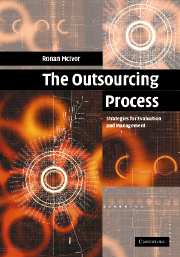Book contents
- Frontmatter
- Contents
- List of figures
- List of tables
- List of illustrations
- Acknowledgements
- 1 Introduction
- 2 The trend towards outsourcing
- 3 Theoretical influences on outsourcing
- 4 The outsourcing process: a framework for evaluation and management
- 5 Determining the current boundary of the organisation
- 6 Activity importance analysis
- 7 Capability analysis
- 8 An analysis of the strategic sourcing options
- 9 Developing the relationship strategy
- 10 Establish, manage and evaluate the relationship
- 11 Case study – outsourcing experiences at Telco
- 12 Conclusions
- Index
- References
2 - The trend towards outsourcing
Published online by Cambridge University Press: 21 August 2009
- Frontmatter
- Contents
- List of figures
- List of tables
- List of illustrations
- Acknowledgements
- 1 Introduction
- 2 The trend towards outsourcing
- 3 Theoretical influences on outsourcing
- 4 The outsourcing process: a framework for evaluation and management
- 5 Determining the current boundary of the organisation
- 6 Activity importance analysis
- 7 Capability analysis
- 8 An analysis of the strategic sourcing options
- 9 Developing the relationship strategy
- 10 Establish, manage and evaluate the relationship
- 11 Case study – outsourcing experiences at Telco
- 12 Conclusions
- Index
- References
Summary
Introduction
The increasing prevalence of outsourcing has led to it being considered central to the strategic development of many organisations. Outsourcing is increasingly being employed to achieve performance improvements across the entire business. For example, one particular growth area has been the externalisation of Information Technology (IT) with a recent report showing companies outsourcing 38% of their IT functions to external providers (Barthelemy, 2001). Another area of the business that is also increasingly being outsourced is the human resource function. An American Management Association survey found that 77% of firms surveyed in the US had outsourced a number of human resource activities including training and development, executive recruitment and payroll management (Anonymous, 1997). The outsourcing decision can often be a major influence on the profitability and competitive position of the organisation. However, many organisations possess a limited understanding of outsourcing and in particular the potential benefits and risks and how they should be managed. This chapter provides an overview of the outsourcing concept. It outlines a number of key developments in the business environment that have occurred including globalisation, advances in information technology, reforms in the public sector and more demanding consumers. These changes have forced organisations to be more flexible and responsive to customer needs. As a result, many hierarchically controlled organisations that have previously performed the majority of business activities internally have been forced to create more network-oriented organisational structures, which involves outsourcing activities to specialist suppliers.
- Type
- Chapter
- Information
- The Outsourcing ProcessStrategies for Evaluation and Management, pp. 6 - 39Publisher: Cambridge University PressPrint publication year: 2005



